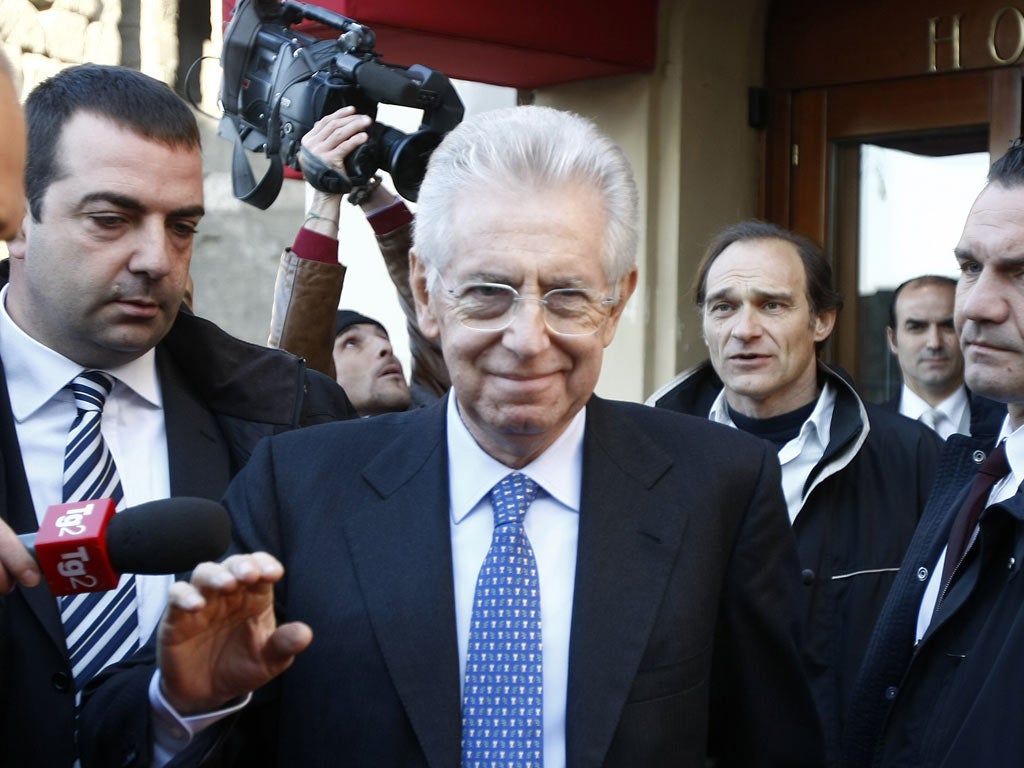Italy: Monti races to put unity government together
Continuing nervousness in markets adds urgency to challenge faced by the country's new premier

Italy's new Prime Minister-designate, Mario Monti, has begun a week of frenetic meetings with politicians, business leaders and unions, in the race to have a new national unity government sworn in by Friday.
There was continued nervousness yesterday in the money markets, as Italy sold €3bn (£2.6bn) of five-year bonds paying a yield of 6.29 per cent – the highest since 1997 – in order to service debt payments.
Friday's gains in share prices on news that austerity measures would pass through parliament were also wiped out at the prospect of several days of "delicate and crucial" negotiations, in the words of President Giorgio Napolitano, between Mr Monti and Italy's fractious political groupings.
The interest rate on Italian 10-year debt fell yesterday morning as investors took comfort from the installation of Mr Monti, but by the end of the day yields had risen back up to 6.7 per cent, a level that is still likely to make it impossible for Rome to meet all its borrowing costs. Despite this, senior political figures predicted Mr Monti will win the backing of enough parties to launch a national unity government by the end of the week to face Italy's debt crisis. Gianfranco Fini, speaker of the lower house of parliament, said: "I believe the Monti government will be created and by the end of Friday will have received [votes of confidence] in both houses of parliament." Along with the outright opposition of the Northern League to a technocratic administration, many members of Mr Berlusconi's People of Freedom (PDL) party are suspicious of a government run by a pro-European liberal economist.
The PDL says it will back Mr Monti for now, but has indicated it would like to see fresh elections before the end of the current parliament in 2013.
Mr Fini – seen as a centre-right leader-in-waiting, albeit without much parliamentary support – said that if a Monti government proved competent and was able to extricate Italy from the financial crisis, it could continue through to 2013.
Mr Monti himself made clear that he intends to serve until spring 2013 elections, calling it counterproductive to say when he'd step down. "If a date before [2013] is set, this haste would take away credibility from the government's actions," he said at his brief news conference. "I won't accept" such a condition, he added. Mr Monti, an economist trained in Italy and Yale in the US, was nominated by Mr Berlusconi as internal markets commissioner in 1994, before taking over the competition portfolio in 1999, which he held for five years.
He made his name in the competition job, taking on the US corporate giants General Electric and Microsoft, blocking GE's planned merger with rival Honeywell and imposing a record €497m fine on Microsoft for anti-competitive practices.
Italian politics: A bluffer's guide (click here to launch the graphic)
The task facing Mario Monti is made harder by the complex nature of Italian politics. The head of state is the President, currently Giorgio Napolitano, who has powers to veto new laws, disband parliament and call elections.
His other chief role is to nominate the President of the Council of Ministers, or Prime Minister, as he did with Mr Monti, the prime minister designate.
The lower house of parliament, the Chamber of Deputies, has 630 members. A parliament can last five years, but as we've seen before – most recently in the past week – rarely goes the distance.
The latest version of Italy's complex electoral system, introduced just six years ago, combines proportional representation with extra representation for the coalition that secures the most votes.
Parliament's upper house, the Senate, has 315 members elected under a system of purely proportional representation. Additionally, the Senate includes former presidents and up to five life-senators – of whom Mario Monti is the latest. Power nominally rests with the Chamber of Deputies, but most bills in Italy do need to pass through both houses.
A brief history
1945 Former dictator Benito Mussolini is executed by partisans a month after Germany surrenders.
1946 Italy votes to become a republic.
1948 New constitution passed. Centre-right Christian Democrats enter government and stay, under numerous different leaders and coalitions, until 1980.
1972 Giulio Andreotti is named Prime Minister. He will come and go as leader seven times over 20 years.
1983 Socialist Bettino Craxi is sworn in as Prime Minister.
1994 Parliament is dissolved after corruption scandals. Silvio Berlusconi wins landslide victory, but falls when the Northern League withdraws from the coalition. He will return to power in 2001, 2005 and 2008.
2002 Italy joins the euro.
2011 Berlusconi steps down after his government loses a crucial budget vote. He is replaced by former EU commissioner Mario Monti.
Join our commenting forum
Join thought-provoking conversations, follow other Independent readers and see their replies
Comments
Bookmark popover
Removed from bookmarks